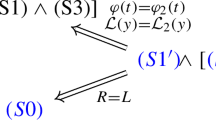Abstract
The classical Birkhoff ergodic theorem states that for an ergodic Markov process the limiting behaviour of the time average of a function (having finite p-th moment, \(p\ge 1\), with respect to the invariant measure) along the trajectories of the process, starting from the invariant measure, is a.s. and in the p-th mean constant and equals to the space average of the function with respect to the invariant measure. The crucial assumption here is that the process starts from the invariant measure, which is not always the case. In this paper, under the assumptions that the underlying process is a Markov process on Polish space, that it admits an invariant probability measure and that its marginal distributions converge to the invariant measure in the \(L^{1}\)-Wasserstein metric, we show that the assertion of the Birkhoff ergodic theorem holds in the p-th mean, \(p\ge 1\), for any bounded Lipschitz function and any initial distribution of the process.
Similar content being viewed by others
References
Bass, R.F.: Markov processes with Lipschitz semigroups. Trans. Am. Math. Soc. 267(1), 307–320 (1981)
Bhattacharya, R.N.: On the functional central limit theorem and the law of the iterated logarithm for Markov processes. Z. Wahrscheinlichkeitstheorie Verwandte Geb. 60(2), 185–201 (1982)
Billingsley, P.: Convergence of Probability Measures, 2nd edn. Wiley, New York (1999)
Blumenthal, R.M., Getoor, R.K.: Markov Processes and Potential Theory. Academic Press, New York (1968)
Bogachev, V.I.: Measure Theory, vol. II. Springer, Berlin (2007)
Butkovsky, O.: Subgeometric rates of convergence of Markov processes in the Wasserstein metric. Ann. Appl. Probab. 24(2), 526–552 (2014)
Chen, M.-F.: From Markov Chains to Non-equilibrium Particle Systems, 2nd edn. World Scientific Publishing Co., Inc., River Edge (2004)
Folland, G.B.: Real Analysis. Wiley, New York (1984)
Hairer, M.: Ergodic properties of Markov processes. Lecture notes, University of Warwick. http://www.hairer.org/notes/Markov.pdf (2006)
Hairer, M., Mattingly, J.C., Scheutzow, M.: Asymptotic coupling and a general form of Harris’ theorem with applications to stochastic delay equations. Probab. Theory Relat. Fields 149(1–2), 223–259 (2011)
Hernández-Lerma, O., Lasserre, J.B.: On the classification of Markov chains via occupation measures. Appl. Math. (Warsaw) 27(4), 489–498 (2000)
Kallenberg, O.: Foundations of Modern Probability. Springer, New York (1997)
Meyn, S.P., Tweedie, R.L.: Stability of Markovian processes. II. Continuous-time processes and sampled chains. Adv. Appl. Probab. 25(3), 487–517 (1993)
Meyn, S.P., Tweedie, R.L.: Markov Chains and Stochastic Stability, second edition edn. Cambridge University Press, Cambridge (2009)
Miculescu, R.: Approximations by Lipschitz functions generated by extensions. Real Anal. Exch. 28(1), 33–40 (2002/2003)
Schilling, R.L.: Conservativeness and extensions of feller semigroups. Positivity 2, 239–256 (1998)
Schilling, R.L., Wang, J.: Strong Feller continuity of Feller processes and semigroups. Infin. Dimens. Anal. Quantum Probab. Relat. Top. 15(2), 1250010 (2012)
Tweedie, R.L.: Topological conditions enabling use of Harris methods in discrete and continuous time. Acta Appl. Math. 34(1–2), 175–188 (1994)
Villani, C.: Optimal Transport. Springer, Berlin (2009)
Author information
Authors and Affiliations
Corresponding author
Rights and permissions
About this article
Cite this article
Sandrić, N. A Note on the Birkhoff Ergodic Theorem. Results Math 72, 715–730 (2017). https://doi.org/10.1007/s00025-017-0681-9
Received:
Accepted:
Published:
Issue Date:
DOI: https://doi.org/10.1007/s00025-017-0681-9



